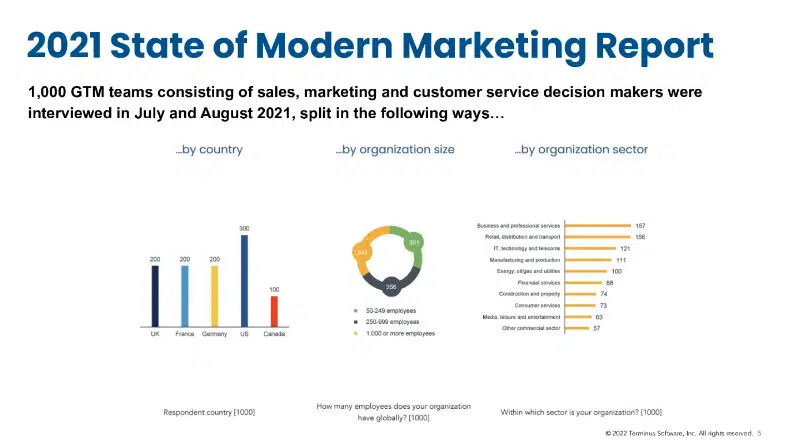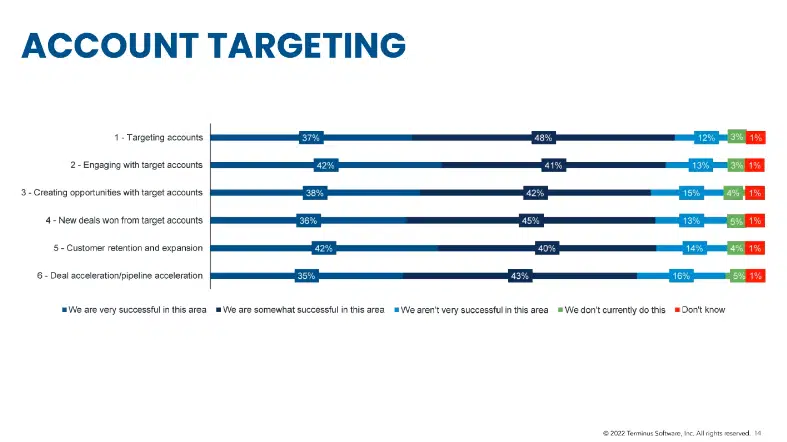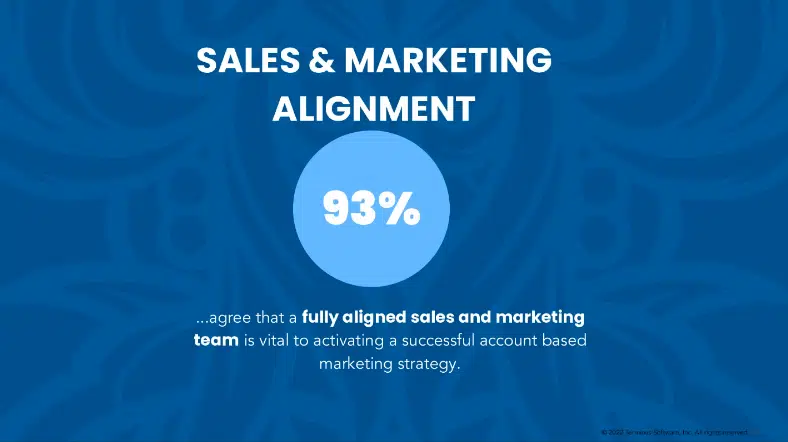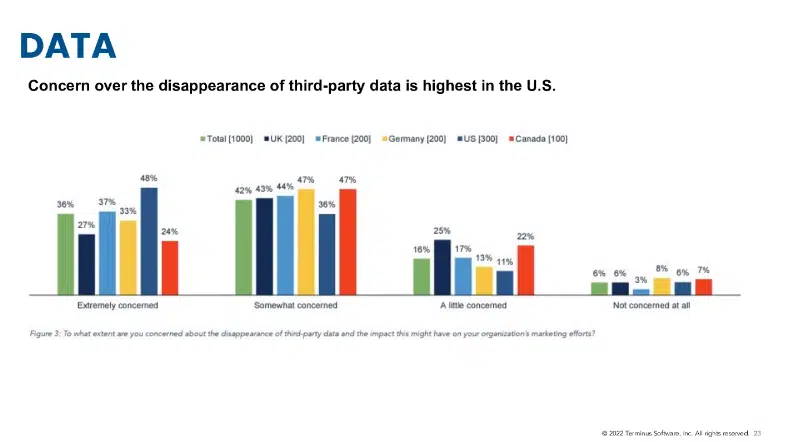Learnings from MarTech Webinar Speaker on ABM
Auseh Britt of Terminus unpacks tactics to help marketers improve their ABM strategies.
Auseh Britt, vp of growth marketing at account-based marketing platform Terminus, recently hosted a webinar that discussed her organization’s 2021 State of Modern Marketing Report. The study polled over 1000 go-to-Market (GTM) teams — groups tasked with identifying the best ways to reach specific marketing.
“It was a global report,” she said. “It spanned across various countries, organization sizes, and sectors.”
The goal of bringing so many respondents from different departments and organizations was to pinpoint common issues brands were experiencing in their marketing campaigns. And the data was telling: 90% of marketers surveyed said they wanted to target customers through customized approaches, using personalized campaigns and sales outreach.

“One of the things that we learned in this report was that B2B has been evolving over the last several years,” Britt said. “We’re moving away from that traditional demand generation linear funnel and more to an account-based marketing structure, where marketing, sales, and customer success are working together in concert.”
She noted that the report also found faster brand adoption of account-based marketing (ABM) strategies: “A lot of that was expedited by the pandemic: When the pandemic occurred in early 2020, a lot of us marketers saw one of our main tactics and channels evaporate overnight. By this, I mean life events.”
To make up for this loss of marketing opportunities, Britt recommends marketers ensure their ABM strategies are optimized across their digital channels. Here are four ways brands can improve their audience targeting with ABM.

More B2B marketers are adopting account-based marketing than ever before. Find out why and explore the ABM platforms making it possible in the latest edition of this MarTech Intelligence Report.
Target “best-fit” accounts
Britt pointed out that the main focus in marketing has shifted to “best-fit accounts” — those consumers that fit your ideal customer profile and provide the highest potential value to your brand. She suggests marketers put more resources into identifying these customers to help improve their ABM campaigns.
“One of the areas with the most room for improvement is account targeting — specifically deal acceleration and pipeline acceleration,” she said.

Britt sees these areas as opportunities to move leads faster through the sales funnel, which can hopefully increase deal sizes throughout the process.
“You have to have a good sense of who you’re targeting, but one of the challenges is determining the right stage they’re in,” she said. “If they’re too early in the customer journey, they may not be quite ready to engage. There may be some opportunities to hone that.”
Marketers should consider implementing pipeline acceleration tasks, which can help strengthen ABM strategies by increasing the volume of leads while ensuring relevant content reaches customers at each stage of the funnel. ABM platforms can help marketers personalize these journeys and secure those best-fit accounts.
Align sales and marketing teams
Marketing and sales teams rely on each other to drive leads through the pipeline, but misaligned tasks often derail their respective operations.
“I cannot overemphasize how critical it is that you have this alignment … I think everyone needs to be in agreement over what that looks like,” Britt said

Marketing and sales teams should align on KPIs as well. Many of the discrepancies that arise between these departments come from the differences in performance tracking — sales may be focusing on lead numbers while marketing hones in on lead quality or brand awareness. While both sets of metrics are important, these teams can find more success with target accounts by reporting on the same goals. Then, they can use the insights gleaned to improve their campaigns and avoid unintentional discrepancies in customer journeys.
KPI alignment is absolutely crucial, but Britt says the execution of the strategy is the most important alignment element to succeed in ABM.
“That’s where you see most of the success,” she said. “If marketing is running their programs and campaigns to target accounts, but sales isn’t doing outbound prospecting to those target accounts at the same time, you’re not going to see the success that you want.”
Use first-party data to fuel the ABM strategy
Customer data is the fuel that powers any successful ABM strategy. However, with the disappearance of third-party cookies on the horizon, many marketers are trying to figure out alternative ways to collect this valuable information.
“There’s quite a bit of concern over the disappearance of third-party cookie data,” Britt said. ”Companies need to think about how they’re using this information — it’s only going to increase the importance of first-party data.”

First-party customer data is key to successful ABM strategies because it provides marketers with relevant insights straight from consumers themselves. And, because it’s information users have consented to share (which adheres to data compliance regulations), marketers can personalize campaigns with this data to help build customer trust.
“That [first-party data] is the most valuable data that you’re going to have,” said Britt. “This trend is only going to increase, so it’s important to have a strategy regarding how you’re going to rely less on third-party cookie data and more on your internal first-party data.”
Prioritize campaign attribution measurement
“For marketers, attribution has always been a challenge,” Britt said. “We have lots of tools that we use … We’re trying to get as much information as possible to know which channels are most effective.”
“But when you move to an account-based marketing strategy, it’s more about the accounts that are engaging,” she added.
Multichannel attribution helps marketers measure customer engagement. ABM campaigns in the past focused on singular channels such as email, but now customers encounter brands across a wide variety of channels and demand personalized, seamless experiences. Multichannel attribution helps marketers identify each touchpoint in customer journeys to help determine which elements lead to conversions and other high-value KPIs.
“At the end of the day, determining if your marketing works depends on looking at those macro types of metrics like account engagement,” she said. “Are you generating opportunities from these accounts that you care about? Are you creating pipeline from these accounts that are then turning into revenue?
“That’s what we care about: How much revenue are we closing from the efforts that we’re putting out there?” she added.
Watch this webinar presentation at Digital Marketing Depot.
Account-based marketing: A snapshot
What it is. Account-based marketing, or ABM, is a B2B marketing strategy that aligns sales and marketing efforts to focus on high-value accounts.
This customer acquisition strategy focuses on delivering promotions — advertising, direct mail, content syndication, etc. — to targeted accounts. Individuals who may be involved in the purchase decision are targeted in a variety of ways, in order to soften the earth for the sales organization.
Why it’s hot. Account-based marketing addresses changes in B2B buyer behavior. Buyers now do extensive online research before contacting sales, a trend that has accelerated during the COVID-19 pandemic. One of marketing’s tasks in an ABM strategy is to make certain its company’s message is reaching potential customers while they are doing their research.
Why we care. Account engagement, win rate, average deal size, and ROI increase after implementing account-based marketing, according to a recent Forrester/SiriusDecisions survey. While B2B marketers benefit from that win rate, ABM vendors are also reaping the benefits as B2B marketers invest in these technologies and apply them to their channels.
Dig deeper: What is ABM and why are B2B marketers so bullish on it?
Contributing authors are invited to create content for MarTech and are chosen for their expertise and contribution to the martech community. Our contributors work under the oversight of the editorial staff and contributions are checked for quality and relevance to our readers. MarTech is owned by Semrush. Contributor was not asked to make any direct or indirect mentions of Semrush. The opinions they express are their own.
Related stories
New on MarTech